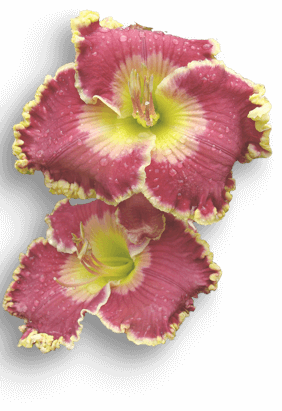Gregor Mendel (1822-1884) wrote: “… those characters which are transmitted entire, or almost unchanged in the hybridization, and therefore in themselves constitute the characters of the hybrid, are termed the dominant, and those which become latent in the process recessive. The expression ‘recessive’ has been chosen because the characters thereby designated withdraw or entirely disappear in the hybrids, but nevertheless reappear unchanged in their progeny …” (1)
Geneticists now know that dominance is much more complicated than what Gregor Mendel learned from his experiments of the 1860s. See Dow’s 2010 Daylily Journal article (2) which explains the modern concept of dominance. Conclusive, quantitative, genetic studies are needed to determine the exact inheritance patterns of daylily characteristics. Those that seem to be cases of simple dominance and recessiveness are likely more complicated at the genetic level than they appear based on visual characteristics alone.
From the Encyclopedia of Ecology: “As Gregor Mendel noted in his seminal paper of 1865, it had been known for some time that hybrids are usually not exactly intermediate between the parental species. Mendel introduced the term dominant to refer to characters that are transmitted almost unchanged to the hybrids, and recessive to those that become latent. In the meantime, more than a century of genetics has shown that dominance is a ubiquitous phenomenon with most deleterious mutations being recessive. Dominance is not only ubiquitous, but clearly of great evolutionary importance because it masks the effects of deleterious mutations as long as they are rare and occur predominantly in heterozygous individuals. Mutations are rarely completely dominant or recessive, but usually intermediate, also called codominant. Complete absence of dominance is uncommon, however….” (3)
“It is also well established now that dominance is a property of the phenotype and not the gene because genes that affect several traits can be dominant for one trait and recessive for another.” (3)
References:
(1) Mendel, Gregor. (1866). Versuche über Plflanzenhybriden. Verhandlungen des naturforschenden Vereines in Brünn, Bd. IV für das Jahr 1865, Abhandlungen, 3–47
(2) Dow, Maurice A. (2010). Part 1: Understanding genotype and phenotype. Daylily Journal. Spring. American Hemerocallis Society, 12-14.
(3) Bürger, R; Bagheri, H C (2008). Dominance and Its Evolution. In: Jorgensen, S E; Fath, B. Encyclopedia of Ecology. Amsterdam, 945-952.

